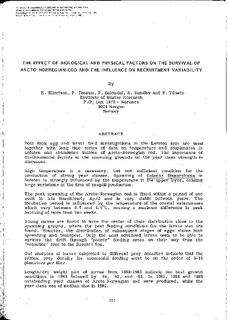The effect of biological and physical factors on the survival of Arcto-Norwegian cod and the influence on recruitment variability
Conference object
Permanent lenke
http://hdl.handle.net/11250/107577Utgivelsesdato
1987Metadata
Vis full innførselSamlinger
- Symposium proceedings [168]
Sammendrag
Data from egg and larval field investigations h the Lofoten area are used
together with long time series of data on temperature and zooplankton in
Lofoten and abundance indices of Arcto-Norwegian cod. The importance of
environmental factors at the spawning grounds on the year class strength lis
discussed.High temperature is a necessary, but not sufficient condition for the
production of strong year classes . Spawning of Calanus finmarchicus in
Lofoten is strongly influenced by the temperature in the upper layer, causing
large variations in the time of nauplii production. The peak spawning of the Arcto-Norwegian cod is fixed within a period of one
week in late Marchlearly April and is very stable between years. The
incubation period is influenced byo the temperature of the coastal watermasses
which vary between 0.5 and 4.5 C, causing a maximum difference in peak
hatching of more than two weeks. Young larvae are found to have the center of their distribution close to the
spawning ground, where the best feeding conditions for the larvae als0 are
found. However , the distribution of subsequent stages of eggs shows both
spreading and transport. Only the most advanced larvae seem to be able to
survive the drift through T'poorer" feeding areas on their way from the
"retentionTt area to the Barents Sea. Gut analyses of larvae subjected to different prey densities indicate that the
critical prey density for successful feeding must be on the order of 5-10
plankter s per liter. Lengthldry weight plot of larvae from 1982-1985 indicate the best growth
conditions in 1983 followed by -84, -82, and -85. In 1983, 1984 and 1985
out standing year classes of Arcto-Norwegian cod were produced , while the
year class' was of medium size in 1982.
Beskrivelse
The effect of oceanographic conditiond on disrtibution and population dynamics of commerical fish stocks in the Barents Sea. Proceedings of the third Soviet-Norwegian Symposium. Murmansk, 26-28 May 1986.
Serie
PINRO-IMR Symposium3
